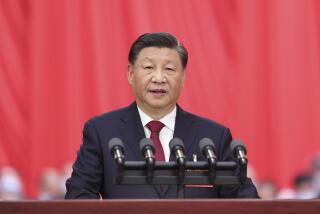Despite Pressures, China’s Economy Grew 7.8% in ’98
- Share via
SHANGHAI — Kick-started by massive government spending, China’s economy grew 7.8% this year at a time when the rest of Asia dropped into recession.
Though the figure announced Wednesday fell slightly short of the targeted 8% growth rate for gross domestic product, it was considered a political and economic victory for a country facing dire financial pressures at home and from abroad. But economists say 1999 will be much tougher, as the country starts to grapple with reforms that were delayed this year.
“China defied the doom-and-gloom predictions this year,” said Frederick Hu, an economist at investment bank Goldman, Sachs & Co. in Hong Kong. Without the government fiscal stimulus program, the growth rate would have been closer to 4%, he said, and the real test is yet to come.
“They have to speed up reforms but also have to keep up the growth and stability,” Hu said. “It’s always a delicate balance.”
The last 12 months brought special challenges. At the same time China was about to launch radical market reforms that would throw millions out of work, the Asian economic crisis caused the two traditional engines of the country’s economy to sputter.
Export growth fell to zero, and actual foreign investment dropped 11% to $40 billion as Asian consumers and investors disappeared. Devastating summer floods knocked another point off projected economic expansion.
“Reaching 7.8% growth is really a hard-earned result that has been attained under a complicated international situation and with serious domestic natural disasters,” Ye Zhen, spokesman for the State Statistical Bureau, said Wednesday.
Most of that expansion has been home-grown. To create jobs and put spending money in people’s pockets, Beijing launched a massive spending program similar to American make-work projects that lifted the country out of the Depression in the 1930s.
In August, after the floods, the government announced a $12-billion bond-financed infrastructure spree. State banks gave out another $12 billion in loans to prop up ailing state-owned enterprises.
The goal was to avoid more layoffs--unemployment is pushing 9% and, above all else, authorities fear social unrest. Factories that had closed their doors fired up again, and projects once deemed unnecessary were restarted.
But guaranteeing growth has come at the cost of some of China’s ambitious market reforms. This was to be the year that saw dinosaur-like state-run factories converted into more competitive companies, the bloated bureaucracy cut in half and the debt-ridden banking system overhauled. Most of the reforms have been slowed or postponed.
“They’re firefighting right now,” said Chi Lo, research director of Hongkong Bank’s China services. “The government measures have been effective on a short-term basis, but they can’t go on forever.”
Economists have expressed concern over the quality of growth versus the quantity.
The GDP figures, for example, count factory production instead of sales. State sector profits fell 60% this year, and one analyst estimated that a full percentage point of third-quarter growth went straight into stockpiles of surplus goods. China is already plagued by overcapacity, and fresh loans to noncompetitive factories mean even more warehouses are full of unsold shirts or televisions.
China’s premier and economic czar, Zhu Rongji, has staked his political life on reform of state-owned enterprises and has given managers two years to pull their factories out of the red. But even he recognizes that the hard-line tactics may be backfiring.
At an economic conference this month, Zhu reportedly chastised provincial officials for inflating statistics to meet government targets. One province, Guanxi, claimed a growth rate of 16% for 1998.
“The figures have been well-massaged from the ground up,” said Bob Broadfoot, managing director of Political & Economic Risk Consultancy in Hong Kong. “If you don’t meet the targets, you lose your job in a year when they are trying to halve the bureaucracy.”
Still, analysts reserve praise for China’s economic accomplishments this year. Inflated figures or not, China still has the fastest-expanding economy in the world.
The government kept the currency stable, despite pressure from manufacturers to devalue it as rival Asian countries did. A devaluation would make its exports more competitive, but would have severely damaged its struggling neighbors.
And although plans to streamline the bureaucracy stalled before they reached the provinces, the central government reduced 40 ministries to 29 through cuts and mergers.
China is not backtracking on market-oriented reforms, says Hu of Goldman Sachs. It is just trying to avoid abrupt economic and social upheaval at a time when it can least afford it.
“There’s no quick fix,” Hu said. “The risks are just too large.”
More to Read
Sign up for Essential California
The most important California stories and recommendations in your inbox every morning.
You may occasionally receive promotional content from the Los Angeles Times.










